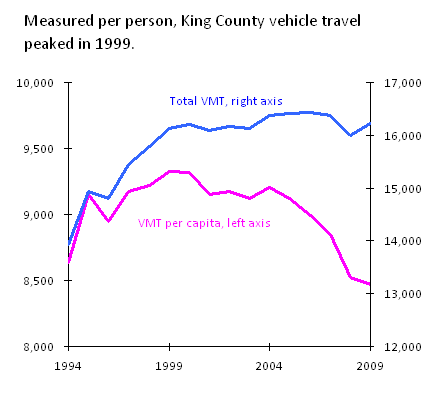I said I wouldn’t post a new one for a while, but apparently I just can’t help myself. Here’s a chart of VMT per capita in King County, Washington, based on data provided by the state department of transportation. (Here’s the VMT data, and the population counts.)
As you can see, total vehicle travel in the county was basically flat from 1999 to 2009. But the county’s population grew over the same period, meaning that vehicle travel per capita fell by 9 percent.
I’ll say it again: transportation models say this sort of thing simply doesn’t happen. Yes, we’ve been through a couple of recessions over the last decade. Yet population and the region’s economic output grew, and traffic volumes still remained flat. And the per capita decline started before gas prices soared, and well before the economy cratered. So to me, it’s hard to avoid the notion that transportation planners have to abandon their assumptions of endless traffic growth. About a decade ago, something, or more likely some combination of things — demographics, psychographics, fuel prices, frustration with congestion, development patterns, and basic economics — started changing our relationship with our cars.









Alf Hanna
Where are the calculations behind this? The city site doesn’t actually call it out.
sara
AGREE with comment above. Also would like more/clearer explanation re what VTM per capita, purple left axis means as opposed to blue VTM, right axis… Thanks.
Clark Williams-Derry
Yikes, I should have labeled the right axis better.
The purple line is just the exact same VMT per capita data that was reported by King County, on a different scale andas a line chart rather than a bar chart.
The blue line is VMT per capita multiplied by population. But (my bad!) it should be labeled as millions of miles. That is, the right axis should range from 12 billion to 17 billion total vehicle miles traveled per year. That’s a lot, I know, but it’s what happens when you have almost 2 million people driving well over 8,000 miles per capita.